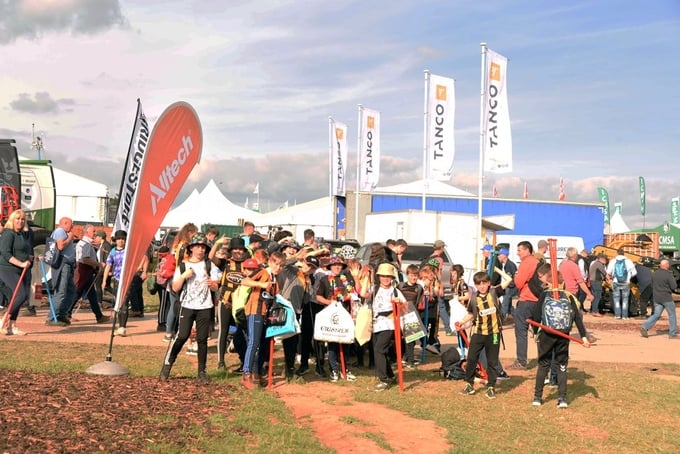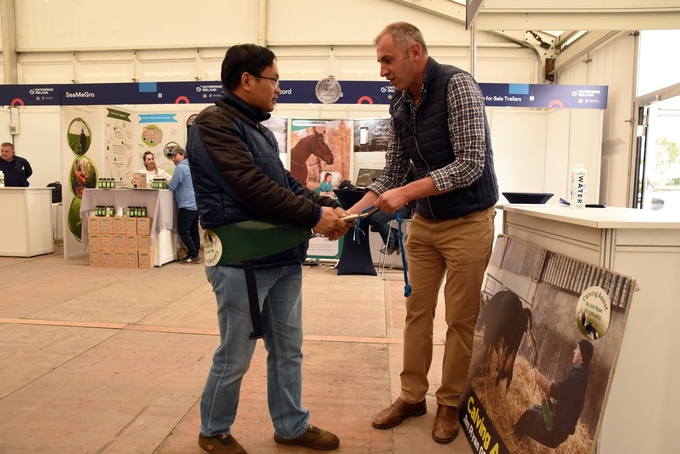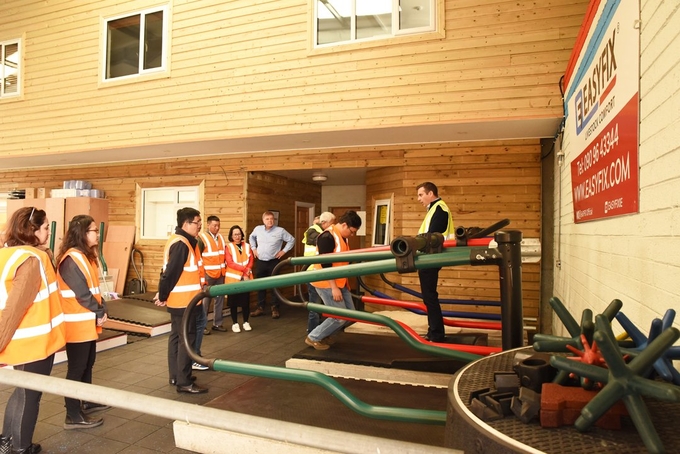May 24, 2025 | 16:29 GMT +7
May 24, 2025 | 16:29 GMT +7
Hotline: 0913.378.918
May 24, 2025 | 16:29 GMT +7
Hotline: 0913.378.918

The National Plowing Championships 2022 has made its comeback strong and bustliing after a two-year absence due to the Covid-19 pandemic. The exhibition attracts a large number of students of all levels, who both come to learn and participate in festival items.
After a two-year break due to the Covid-19 pandemic, the National Ploughing Championships made a great comeback this year with 1,700 exhibition booths and 277,000 visitors coming to enjoy the three-day event.
Nguyen Le Thang - Agriculture Manager, TH Milk Joint Stock Company said, "Although we do not see some of the world's leading brands in agricultural machinery like John Deer, the presence of brands at the exhibition site surely satisfies the visitors.
“I particularly am impressed with the way Ireland organize the event. They make sure that those wishing to design a farm can find a full suite of solutions at National Plowing Championships 2022, from seeds to machinery equipment, livestock support software, solution for feed and fertilizer for high biomass plants, even materials and design of houses and farms in the field. I also jokingly told my colleagues that anyone who comes here empty-handed can learn about agritech, sign a contract and return home with a world-standard farm."

Those wishing to design a farm will be able to find a complete set of solutions at the National Plowing Championships 2022. According to statistics, about 7% of Irish farmers are under the age of 35.
Such a grand number of exhibition booths, plus the 277,000 visitors participating in National Ploughing Championships 2022 speaks a lot about this wonderful land.
The Irish love agriculture, which partly comes from tradition, and above all, it’s thanks to nature's blessing, having rainfall of 1,000 mm per year but evenly distributed rather than locally approached. And the most favorable point for agricultural production is that Ireland is not too dependent on the irrigation system. This point is coveted by many places, many countries, including Vietnam.
At the Country Crest farm in Laois, the young "third generation" owner, who is growing potatoes, barley, and biomass grass for livestock, said he had only just built the water system, but it was mainly for emergencies. Having good soil, standard varieties, full equipment and evenly distributed rainfall as a gift from nature, his family just needs to put in labor and harvest all year round, not one bit worried about waterlogging and root rot.
Succession in Irish agriculture can be seen very clearly. According to data from the Irish Central Statistics Office in 2020, with a 10-year cycle, 98% of farm owners choose a family member to succeed.
Ireland is slightly more than 70,000 km2 wide, and agricultural land (including forest land) accounts for about 64% of that. According to the latest updated data, the population of this country is just over 5 million people, of which more than 5.5%, or approximately 278,000 people, are directly involved in agriculture. An impressive thing is that the number of full-time farmers in Ireland is on an uptrend, reflected in the increase of 6,600 people compared to ten years ago.

Calving assistance belt - one of the innovative pieces on display at the National Plowing Championships. Trinh Phuong Nam (left) - Director of Agriculture, Vietnam Dairy Co., Ltd (a member of Vinamilk) assessed Irish agricultural enterprises to be very diligent in improving equipment, even to the smallest detail.
Ireland had an agriculture-heavy economy before the 80s of the last century. Thanks to innovation and transition to creative orientation, later they emerged into a modern knowledge economy based on two spearheads of high technology industries and services. However, agriculture still marks a significant contribution to exports thanks to its extremely advanced processing field, mainly showcasing its strength in food and beverages (such as the globally famous Guinness brand). But that is a story for another time.
At a satellite farm that raises about 150 dairy cows using Easyfix's breeding equipment in Galway County, the owner and his father regularly drive the cows twice a day to the milking station, and the machine is already available. Except for some manual operations such as placing the sucking straws, cleaning manure or fixing minor things, after that, they can rest and relax. After being milked, the cows will be pushed along the channel and then wandered out to the adjacent grass fields, absorbing the fresh air from the skin into the meat, making the aroma deeper, the color fresher, the fibers softer, then again produce milk that does not need to be called organic, as the word “organic” comes with its nature.

With the help of Easyfix equipment, livestock will be cared for in a direction that ensures animal welfare.
Now comes some temporary calculations: With 150 cows at Easyfix's satellite farm, 27 liters per day can be obtained from one cow. And with its capacity of milking for 300 days/year and a stable average price of 0.6 EUR/liter of fresh milk, in one year a cow helps the family farm earn approximately 4,860 EUR from selling milk, ie the total income from the whole herd is about 729,000 EUR – VND 17 billion if calculated in Vietnamese currency.

Representatives of TH Milk Joint Stock Company learning about the new software used in livestock management by Alltech.
I don't have the opportunity to compare with other places around Ireland, but technicians working in large dairy enterprises in Vietnam told me, that level is not actually considered high. I believe in their words, so perhaps dairy farmers in Ireland are not “rich” – they are simply well-off.
The disruption caused by the Covid-19 pandemic and Brexit has been well documented, however,Ireland’s economy has been resilient. Despite immense global challenges, Ireland continues to be anexcellent place to invest.
Ireland has long been associated with high quality produce. This remains truetoday as the food sector continues to be a vital industry in the country.
There are currently 11,000 people employed within around 50 companies in the FDI food space located across the country, particularly in regional locations.Along with smaller, innovative firms, many wellknown brands have a well-established presence inIreland including Danone, Abbott, Diageo, Nestle and Mondalez.
Alexa Toomey, Manager of Dairy, Beveragesand FDI at Enterprise Ireland, says there is good reasonwhy these sector giants are attracted to Ireland.“We have a really strong record in partnering withforeign owned companies,” she says. “This countryis a great place for businesses in the food sector as it is our most important industry in terms of the indigenous sector, so we have built up a massive level of expertise.“We have a strong reputation for food safety and food science. There is a huge emphasis on this within our university system along with a very broad government support network through Enterprise Ireland, Bord Bia, Teagasc and the Food Safety Authority of Ireland."
Translated by Samuel Pham

(VAN) Alt Carbon has raised $12 million in a seed round as it plans to scale its carbon dioxide removal work in the South Asian nation.

(VAN) Attempts to bring down the price of the Japanese staple have had little effect amid a cost-of-living crisis.

(VAN) Fourth most important food crop in peril as Latin America and Caribbean suffer from slow-onset climate disaster.

(VAN) Shifting market dynamics and the noise around new legislation has propelled Trouw Nutrition’s research around early life nutrition in poultry. Today, it continues to be a key area of research.

(VAN) India is concerned about its food security and the livelihoods of its farmers if more US food imports are allowed.

(VAN) FAO's Director-General emphasises the need to work together to transform agrifood systems.

(VAN) Europe is facing its worst outbreak of foot-and-mouth since the start of the century.